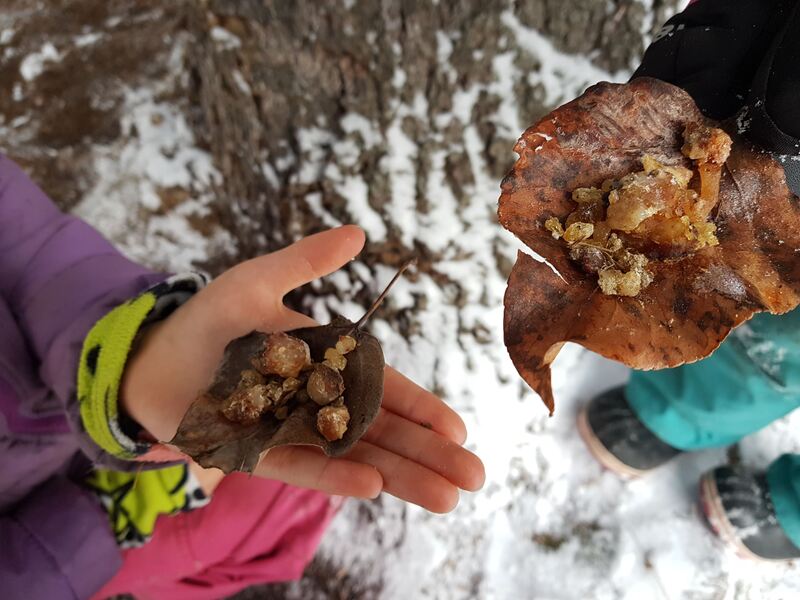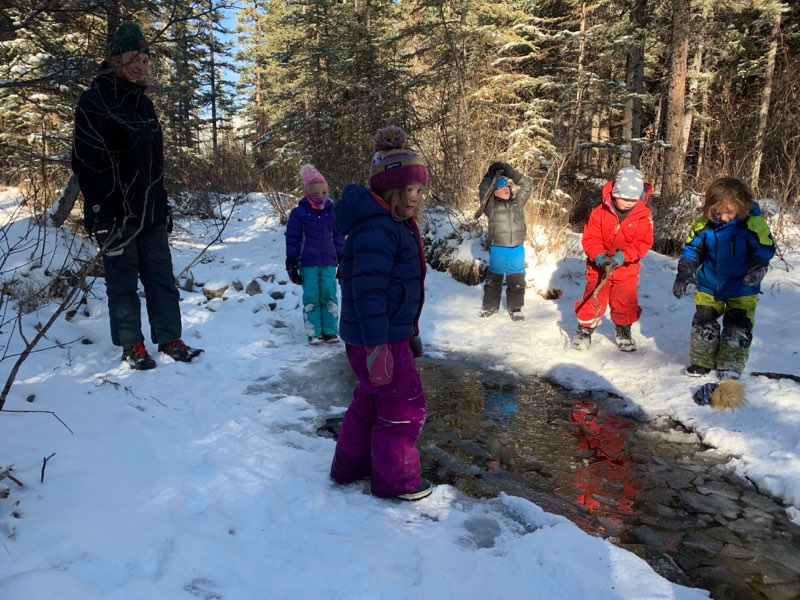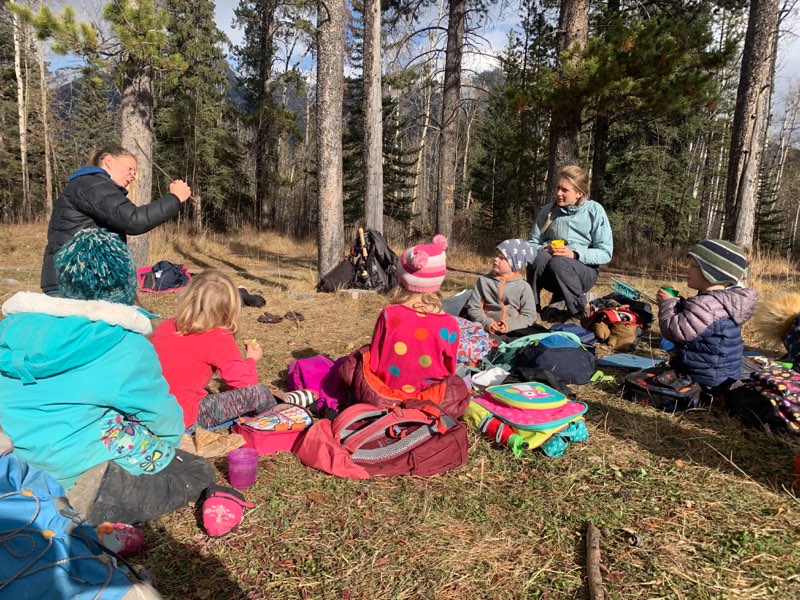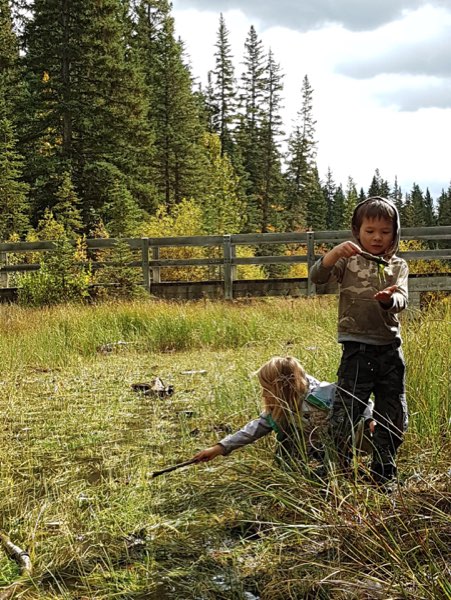Alpenglow School
|
By Heidi Widmer, Heather Stark, Dave Verhulst Squinting optimistically between a pulled-down toque and thick balaclava, the Forest Play Alpenglow Kindergarten class waddle their way through the forest. Despite their warm breath instantly crystallizing onto eyelashes, thick snowsuits impeding mobility notto mention lack of dexterity with gloved hands, the children paid no mind; there was playing to do! The recent -33C
overnight lows in Canmore followed by daytime highs of -25C transformed the forest and play. Branches that swayed now snapped. The forest floor snow squeaked underfoot. Life moved a littleslower, a little more calculated. The cold days at Forest Play reminded us of what winter can mean. It inspired stories of survival, resilience and teamwork. Heather, Dave, Marlou and Siobhan told stories of how the winter elves, Snowflake and Icicle, worked together to help the local wildlife adapt, find food, and have fun in the frigid weather. The children learned about animals closely calculating their movements to conserve energy. There were plenty of giggles, when the elves foundrelief from the cold in the thick winter coat of an elk. The cold snap did more than frost our noses and inspire stories. At Forest Play, the cold instigated play that required a new type of communication, self-awareness and adaptability. On a particularly cold afternoon, the children worked together to move fallen logs from a nearby cut onto a toboggan and then coordinated themselves in order to haul the toboggan a fair distance across the resistant snow. They built the logs up to construct their imagined train station. Persistently hauling logs back-and-forth from the cut tree to the “construction site” required communication and teamwork not to mention physical strength! Snow shovelling, path building and digging were also popular outdoor activities that generated warmth and took on a new life in the cold. When the cold seeped past buffs and scarves, mitts and boots, the wood stove in our canvas tent welcomed us. Forest Play staff noticed considerable growth in the children’s self-awareness as they learned to check in with their fingers, toes, and cheeks and seek a warm-up before reaching the point of discomfort. Many were keen to go back outside once they were warm while the tent hummed with others participating in finger knitting, eagle eye crafting,carving, crayon sketching, impromptu tea parties. We feel grateful for the contrast in weather and persistent optimism of the Kindergarten class. The play in the forest we observed during the deep-freeze demonstrated unique progress in the children’s resiliency, self-awareness, teamwork, physical strength, adaptability and communication skills. Although we are happy to greet the warmth of the sun again, there is nothing quite like a view framed by crystallized eyelashes.
1 Comment
By: Heidi Widmer (with contributions from Heather Stark and Dave Verhulst Winter solstice is fast approaching. At Forest Play, the return of light is timed with a transition of our storytelling characters in our 4-6 yr old program. Leif and Autumn, who the children have come to known as the “fall elves”, retire from their duties in the forest for the season and invite the winter elves, Snowflake and Icicle, to take care of the forest and its inhabitants for the winter season.
Caring for the plants and animals is a gift that the elves share with the forest. In our stories, that gift is reciprocated as trees, plants and the animals that live in the forest provide the elves the gifts they need for their well-being and safety: food, shelter, water, friendship, belonging and purpose. Gift giving and sharing are important daily practices at Forest Play. After each session of Forest Play, we share a cup of tea steeped in wild edibles harvested earlier that day - rose hips, spruce needles, juniper berries and Labrador tea have been favourites this fall. We also take time at the end of the day to share what moments or gift we received that day in our “Story of the Day” routine. As we head into the season most readily associated with giving gifts and sharing, we would like to share the physical, emotional and social gifts nature presents us at Forest Play. When the children in Forest Play explore their physical surroundings in the colder months, they receive gifts in many shapes, sizes and experiences. The natural world gives the children the gift of fallen logs to maneuver over, ice to slide on, snow drifts to wade through, hills to slide down, wild edibles to harvest, fresh air to breathe and wildlife to observe and imitate. The adventures of the fall forest elves, Leif and Autumn, exploring their physical surroundings by sliding down slopes like the river otters or sprinting away like a snowshoe hare frequently weave their way into the children’s play. There is no better place for children to build physical literacy and stamina than by running and sliding through the forest imitating the animals who live there! Nature also presents us and the children with the gift of space to process feelings and develop emotional and social well-being. The children are able to interact with one another outdoors through rough play, imaginative play and risky play to process and express their feelings of fear, love, patience, frustration or happiness. Developing the skill of processing and understanding emotions takes time and often a little coaching from trained mentors. We have seen tremendous growth in the ability of children to process their feelings in productive and positive ways this season! During play, children develop their emotional intelligence and well-being as they navigate their feelings and witness the emotions of their peers. Sometimes, frustration occurs while climbing up the hill at the end of the day when they are tired and hungry. It may be hard on the first day, but after they do it, they realize it is possible and the next time it is a little easier because they become stronger emotionally and physically. The search for “the perfect stick” takes patience and if it is lost or misplaced, they learn problem solving techniques and also how to help each other when in need. The joy the children express when they find “the perfect snow slide” echoes throughout the forest…sometimes for over an hour! When the children engage in imaginative play, it often involves modelling after a mother/father and baby animal scenario. In role play, the children are able to experiment and strengthen their self-awareness and social well-being as they act out feelings associated with caregiving, responsibility, being lost or injured, reliance, independence and acceptance. As children help one another up a slippery slope or put their backpacks on, they are practicing interpersonal communication skills and further strengthening their connection to one another and social well-being. As we prepare for the winter elves, Icicle and Snowflake, to appear on winter solstice, we want to wish you a happy holiday season filled with opportunities to explore the abundant gifts of nature. Happy New Year! Heidi, Dave & Heather. Supporting Research: Forest Play facilitates the afternoon programming for the Alpenglow Kindergarten. In mid-November, Forest Play Director, Dave Verhulst, presented a keynote address at the 2019 Calgary Play Summit. Hosted by the City of Calgary at the Calgary Zoo, the summit fostered discussion and ideating amongst one hundred educators, policy-makers and professionals in the field of childhood development. Dave’s presentation skillfully used the art of storytelling to portray the methods and practices of Forest Play from the perspective of Grandmother Spruce- an observant, grandmotherly tree interested in what was happening with the “two leggeds” who were frequenting visitors to her forest. The story highlighted a few experiences from the past eight years of Forest Play programs that illustrated how we build connection to nature, self and others through play.
The YYC Play conference reinforced that play is not just important, but vital to healthy childhood development; outdoor play even more so! As it turns out, there are over 30 adjectives to describe different forms of play! Everything from parallel play, imaginative play and free play to unstructured play, risky play and forest play ;) A simple thing is paradoxically complex at an event with adults! At Forest Play, we can see that outdoor play is not complicated for children – it is natural. We intentionally create space for play by creating a culture that leads to connection. We research and prepare oral stories informed by local plant, wildlife, landscape, climate and traditional knowledge. As the children sit in a circle and munch away on their lunch, we use storytelling to connect us to our place. Storytelling also engages imagination and empathy skills as the children read and interpret our words, facial expressions, tone and mannerisms. Once the inevitable sitting-squirms and fidgeting set in, it’s time to play! This play is often inspired by the adventures of the elves from the lunchtime story. Recently, upon listening to Ms. Heather narrate how the forest elves helped the beavers build lodges and dams packed in with mud, the kindergarten class scurried into self-directed play and imitated their own versions of the story by collecting sticks and logs to build dams and lodges. Other times, the staff segue the children into their free play by facilitating a game. Ms. Heather, Siobhan and Marlou, for example, led the kindergarten children in a game of “healing-tea tag”. The player who is “it” emulates sickness and freezes those in play, the other players can unfreeze their peers by “healing” or “unfreezing” by tagging them with spruce tips; emulating how spruce tips can help heal sickness. This directed play, although not intrinsically motivated, further connects us to our surroundings and others. Inevitably, the games and whatever “rules” might be there to start, are re-written by the kids in short order and their imaginations create amazing opportunities for connection. Lately, it has been a combination of den/fort building, making imaginary soups, creating challenges for the “crystal lynxes” and countless other play experiences. The YYC Plays conference gave us confidence and hope that the importance of play is becoming more widely understood and appreciated. Children at play outdoors are practicing social skills, experimenting with the edges of their physical abilities, learning to trust their intuition, creatively solving problems and engaging all their senses. Read more on the benefits of playing in nature here Play and more specifically “Risky Play” also has been proven to increase physical literacy, risk assessment, fitness, endurance, spatial awareness and strength (i.e. climbing over fallen logs, climbing trees, playing in creeks and sliding down slopes). This type of play has also been proven to reduce separation anxiety (i.e. from playing hide-and-seek games) and increase emotional self-regulation and fear management. Read more on the importance of risky play here Hearing stories from other attendees at the summit and some of the challenges and concerns they are grappling with helped us to see how fortunate we are to live in Canmore. Forest Play is privileged to operate in a community drawn together by the landscape itself and the similar-minded outdoor fanatics who have chosen to call this place home. Canmore loves being outdoors! We feel fortunate to have your trust to connect your children not just to the beauty of nature, but also to themselves, others and to the uniqueness of life in the Bow Valley. Stay tuned for more Stories from the Forest and how we are guided by play to connect the children to nature, themselves and others. The longer scarves and shorter days are a sure sign that winter is coming! With the most recent Thanksgiving holiday, Forest Play thought it would be an appropriate time to visit the why of gratitude. For us, giving thanks is more than an annual tradition; it is a daily practise and a “core routine” that helps children connect deeply to themselves, nature and others.
“I’m feeling grateful for the birds that we could hear as we walked to this place and for the sun shining down on us as we eat our lunch.” It is common to hear Forest Play leaders express gratitude during our afternoons with the children. By modelling giving thanks, we intend to encourage this practise to become natural for the children. We have found gratitude creates space for the children to practise empathy, improve their self-confidence and support their physical and mental well-being. It appears we’re not alone in our observations. Read more here on 7 scientifically proven benefits of Gratitude (Forbes Magazine). Upon first gathering for Forest Play, we sing a gratitude song to express “wherever you’re from, we’re glad that you’ve come” and give thanks to the gifts in our world; for ourselves, our community and our surroundings. With a few songs and stories, the children at Forest Play naturally take to the practise of gratitude and build upon its benefits with each repetition. Practicing gratitude is timeless. In an age where we are constantly receiving messages about a world that is broken, a practice of gratitude helps to remind us of the good things in life, so we may remain optimistic and positive in our daily approach to life and challenges. As winter fast approaches, we are grateful to the children for being present at Forest Play, our community for their trust and our toques for keeping us warm! Thank you for reading, Heather, Siobhan, Marlou, Dave and Heidi Gold, auburn, ruby and emerald. The colours of fall in Canmore provide the perfect opportunity to awaken our sense of sight in the kindergarten program at Forest Play! Ms. Heather, with the help of Marlou, Dave and Siobhan, is leading the Forest Play portion of the Alpenglow kindergarten program this year and couldn’t be more excited to build connections in the forest.
To engage their sense of sight, the Forest Play kindergarten class play games of camouflage and use their “owl eyes” to spot movement in the forest. The children aren’t the only ones busy in the forest. As winter approaches, the animals are busy preparing to hibernate. After observing the squirrels, play time is often spent mimicking squirrels by collecting pine cones and building nests. Each Forest Play kindergarten session begins with storytelling to capture the children’s imaginations and weave knowledge into the stories. The stories highlight the adventures of the forest elves, Autumn and Leaf, who helped the queen bumblebee prepare to hibernate and the young cougar transition to independence. The children have grown familiar with the adventures of Autumn and Leaf who then guide them through their play and forest exploration. With the fall colours backdropped by snow in the mountains, it won’t be long before we setup the canvas tent for Forest Play. If your child(ren) need more time for play, the Forest Play program on Fridays for children aged 5 to 8 years old still has space available. Please contact Dave, [email protected], to register. |
Stories from the ForestAlpenglow School's Kindergarten afternoon programming works in partnership with Nature's Tracks Forest Play. Nature experiences should be fun, magical and facilitated in a way so that children feel safe and supported as they explore the edges of their world. The program is built around cycles in nature and the life stages children naturally move through. When children are connected to the natural world, they are more connected to themselves, they are happier and more hopeful. Archives
February 2020
|



























 RSS Feed
RSS Feed
